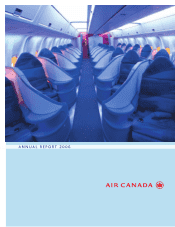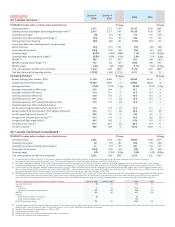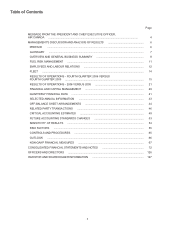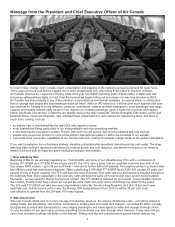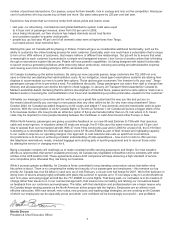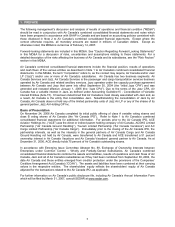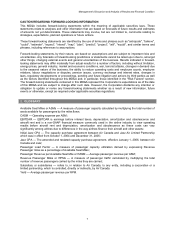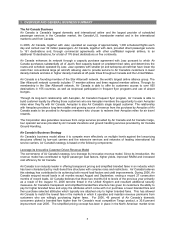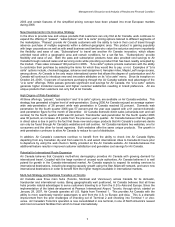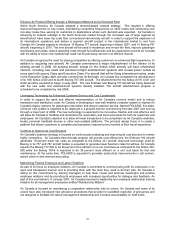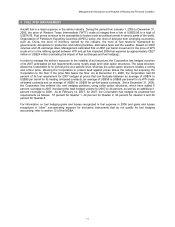Air Canada 2006 Annual Report Download - page 9
Download and view the complete annual report
Please find page 9 of the 2006 Air Canada annual report below. You can navigate through the pages in the report by either clicking on the pages listed below, or by using the keyword search tool below to find specific information within the annual report.
2003 and certain features of the simplified pricing concept have been phased into most European markets
during 2006.
New Developments in Its Innovative Strategy
In the drive to provide new and unique products that customers can only find at Air Canada, work continues to
expand the offering of “passes”, “subscriptions” and “à la carte” pricing options tailored to different segments of
the marketplace. “Passes” provide Air Canada customers with the ability to lock-in their cost of travel through
advance purchase of multiple segments within a defined geographic area. This product is gaining popularity
with large corporations as well as with small business and families who value the set price and more importantly
the flexibility and ease of use. “Subscriptions” to travel are another Air Canada innovation, which allows
unlimited travel within a geographic area and certain conditions, for a set flat fee. “Subscriptions” provide
flexibility and ease of use. Both the pass and subscription products have also provided cost savings to Air
Canada through reduced sales and servicing costs while providing a product that has been readily accepted by
the market. Pass sales increased 148 percent in 2006. “À la carte” options provide customers with the ability
to customize their purchase by selecting the items for which they would like to pay, or not. Examples of “à la
carte“ options include, checked baggage, advance seat assignment, Aeroplan miles, Maple Leaf lounge access,
among others. Air Canada is the only major international carrier that allows this degree of customization and Air
Canada will continue to introduce new and innovative attributes on its “à la carte” menu. Since its inception on
October 28, 2006, 13 percent of customers purchasing through the Air Canada website took advantage of the
“à la carte“ offerings. While passes generate significant cost savings for Air Canada, the “à la carte” options
generate higher incidental revenues and higher customer satisfaction resulting in brand preference. All are
unique products that customers can only find at Air Canada.
High Degree of Web-Penetration
All three offerings, “passes”, “subscription” and “à la carte” options, are available on Air Canada websites. This
strategy has generated a higher level of web-penetration. During 2006 Air Canada enjoyed an average system-
wide web-penetration of 26 percent while web penetration in Canada reached 52 percent. Domestic web
penetration for the fourth quarter 2006 was 57 percent and the year was capped with a 61 percent domestic
web penetration figure for the month of December. Air Canada domestic direct sales (aircanada.com and call
centres) for the fourth quarter 2006 was 69 percent. Transborder web penetration for the fourth quarter 2006
was 30 percent, an increase of 6 points from the previous year’s quarter. Air Canada believes that the growth
in direct sales is due in part to the fact that these new and unique products that Air Canada’s customers desire
can only be found through Air Canada’s websites and call centres. Air Canada maintains two websites, one for
consumers and the other for travel agencies. Both websites offer the same unique products. The growth in
web penetration continues to allow Air Canada to reduce its cost of distribution.
In addition, Air Canada’s customers continue to benefit from the ability to check into Air Canada flights
departing from any Canadian city and from select U.S. and select international cities to Canada 24 hours prior
to departure by using the web check-in facility provided on the Air Canada website. Air Canada believes this
additional feature results in improved customer satisfaction and generates cost savings for Air Canada.
Potential for International Route Expansion
Air Canada believes that Canada’s multi-ethnic demography provides Air Canada with growing demand for
international travel. Coupled with the large number of unused route authorities, Air Canada believes it is well
poised for growth in the Canada-international market. Air Canada expects to expand its existing services to
international destinations, including leveraging capacity growth using the Star Alliance® network, and serve new
international destinations in order to benefit from the higher margins available in international markets.
Multi-hub Strategy and Seamless Transfers at Toronto
Air Canada uses three main hubs (Toronto, Montreal and Vancouver) across Canada for its domestic,
transborder and international routes. Being geographically well positioned, Air Canada believes that all three
hubs provide natural advantages to serve customers traveling to or from the U.S to Asia and Europe. Since the
implementation of the latest development at Pearson International Airport, Toronto, through which, started on
January 29, 2007, Air Canada operates all U.S. flights from Terminal 1. This provides Air Canada with the
ability to more seamlessly transfer passengers to and from the U.S. to Europe and Asia. This is a dramatic
improvement from the prior challenges of checking out of Terminal 2 and checking into Terminal 1 or vice-
versa. Air Canada’s Toronto’s operation is now consolidated in one terminal, in one of North America’s newest
and most convenient facilities from which to travel internationally.
9
Management's Discussion and Analysis of Results and Financial Condition

